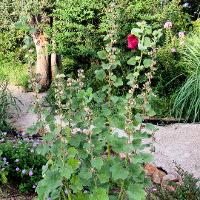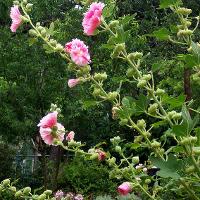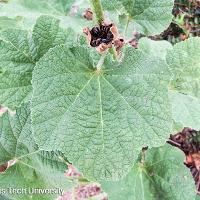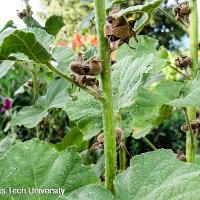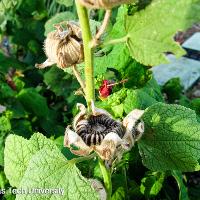Hollyhocks
Alcea rosea
Perennials
Hollyhocks provides large, showy blooms and a strong vertical accent to both the landscape and cut-flower arrangements. In West Texas, it acts as a biennial or weak perennial, and will likely need staking to support the tall stem in the wind.
(Detailed plant information can be found at the bottom of the page.)

Alcea rosea Photo Gallery
Alcea rosea Plant Information
| Classification | |
|---|---|
| Scientific Name: | Alcea rosea |
| Common Name: | hollyhocks |
| Family: | Malvaceae |
| Suggested Uses: | biennials, beds & borders, cutflowers |
| Characteristics | |
| Plant Form: | upright |
| Height: | 3 - 8 feet |
| Spread: | 1 - 2 feet |
| Foliage: | dense base of dark green to gray-green foliage with tall flower stalks alternate, simple, lobed leaves which range from large to smaller from the base to the tip of flower stalk coarse-textured foliage |
| Flower: | large, single, saucer-shaped flowers on 3-8 foot-tall racemes white, pink, red, maroon, purple, or yellow |
| Bloom Period: | Spring - Summer |
| Environment | |
| Sun: | full sun |
| Water: | medium water requirement |
| Soil: | well-drained and moist drought-tolerant once established |
| Heat Tolerance: | medium heat tolerance |
| USDA Zone: | zone 5 |
| Native Range: | Southern Asia |
| Care | |
| Maintenance: | stake in windy locations deadhead fruit to prolong bloom propagation by seed |
| Pests & Pathology: | susceptible to root rot, rust, and spider mites |
| Additional Notes: | acts more as a biennial or weak perennial strong vertical accent piece |
TTU Plant Resources
-
Address
Texas Tech University, Department of Plant and Soil Science, Box 42122, Lubbock, TX 79409 -
Phone
806.742.2838 -
Email
Melanie.Jackson@ttu.edu

